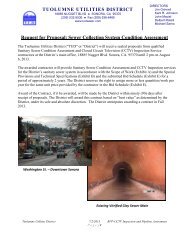Historic Resource Evaluation Project - Tuolumne Utilities District
Historic Resource Evaluation Project - Tuolumne Utilities District
Historic Resource Evaluation Project - Tuolumne Utilities District
Create successful ePaper yourself
Turn your PDF publications into a flip-book with our unique Google optimized e-Paper software.
ditch had been absorbed into the TCWC system; it was thereafter associated with the<br />
TCWC and its successors, one of the largest and most important entities in <strong>Tuolumne</strong><br />
County from 1852 to the present.<br />
Under Criterion C, although paralleling the earlier 1850s ditch in places, the Roach’s<br />
Camp Ditch retains its integrity to its period of significance (ca. 1850s-1967) along about<br />
80% of its length, and embodies the distinctive characteristics of its type, period, and<br />
method of construction. Although the active ditch was truncated after about one and onehalf<br />
miles, instead of continuing southerly to Roach’s Camp and the <strong>Tuolumne</strong> River, the<br />
extant operating segment conveys its integrity of location, design, setting, feeling, and<br />
association, and conveys water in the same manner as when it was first constructed. The<br />
lower section, although no longer in operation and outside of the project boundaries, also<br />
appears to be a contributor as an archaeological property.<br />
San Diego Ditch (P-55-006538)<br />
Description. This resource is a water conveyance system consisting of earthen berm<br />
ditch, siphons (pipe), and two tunnels. From a dual junction box along the Columbia<br />
Ditch, the San Diego contours along a side hill north of Italian Bar Road to a siphon that<br />
crosses Yankee Hill Road, continuing in earthen berms on contour to San Diego<br />
Reservoir, about 3.5 acres in size. The ditch continues, flowing around Kennebec Hill<br />
first in a pipe and pipe-in-tunnel to its terminus near the end of Damin Road at Hippie<br />
Pond. This system is somewhat rural, set in a mixed conifer-oak woodland along<br />
hillsides that were heavily mined during the Gold Rush.<br />
The total length of the ditch is 19,369 linear feet that conveys water managed by the<br />
<strong>Tuolumne</strong> <strong>Utilities</strong> <strong>District</strong> from the Columbia Ditch to the end of Damin Road. There is<br />
5,355 feet of pipe, 289 feet of tunnel, and 13,892 feet of open ditch. Forty-one percent<br />
(41%; 5,710 ft.) of the open ditch is lined with gunite. Segments of the operating ditch<br />
were previously recorded, including those abandoned when the Kennebec tunnel was<br />
constructed. The USGS-mapped ditch is inaccurate in many locations.<br />
Thirteen features were recorded. Only one spillgate with crossgate; four small<br />
archaeological branch ditches/flume channels leading off from the San Diego; a random<br />
replaced by an inverted siphon; a tunnel now with pipe laid in it; a dry-laid rock<br />
reinforcement feature; a lengthy discontinuous segment of similar rock reinforcement; a<br />
formerly flumed segment of ditch through blasted rock; a dry-laid limestone rock<br />
embankment that retains the bank below the ditch; San Diego Reservoir, about 3.5 acres<br />
in size; and a junction structure known as the Tower.<br />
History. The San Diego Ditch was one of the first distribution ditches to be completed<br />
by the TCWC in 1852 and is depicted on Wallace’s 1853 and 1862 maps of the system<br />
(Figures 10, 12). It carried water southerly from Matelot Reservoir to San Diego<br />
Reservoir, from where water was distributed to Copeland’s and Byrd’s reservoirs,<br />
westerly around Kennebec Hill, down Columbia Gulch, through Red Gulch to Saw Mill<br />
Flat, and to numerous placering and hydraulicking claims along its route.<br />
Foothill <strong>Resource</strong>s, Ltd. 4.38 TUD Ditch Sustainability <strong>Project</strong><br />
Francis Heritage, LLC<br />
<strong>Historic</strong> <strong>Resource</strong> <strong>Evaluation</strong> Report




